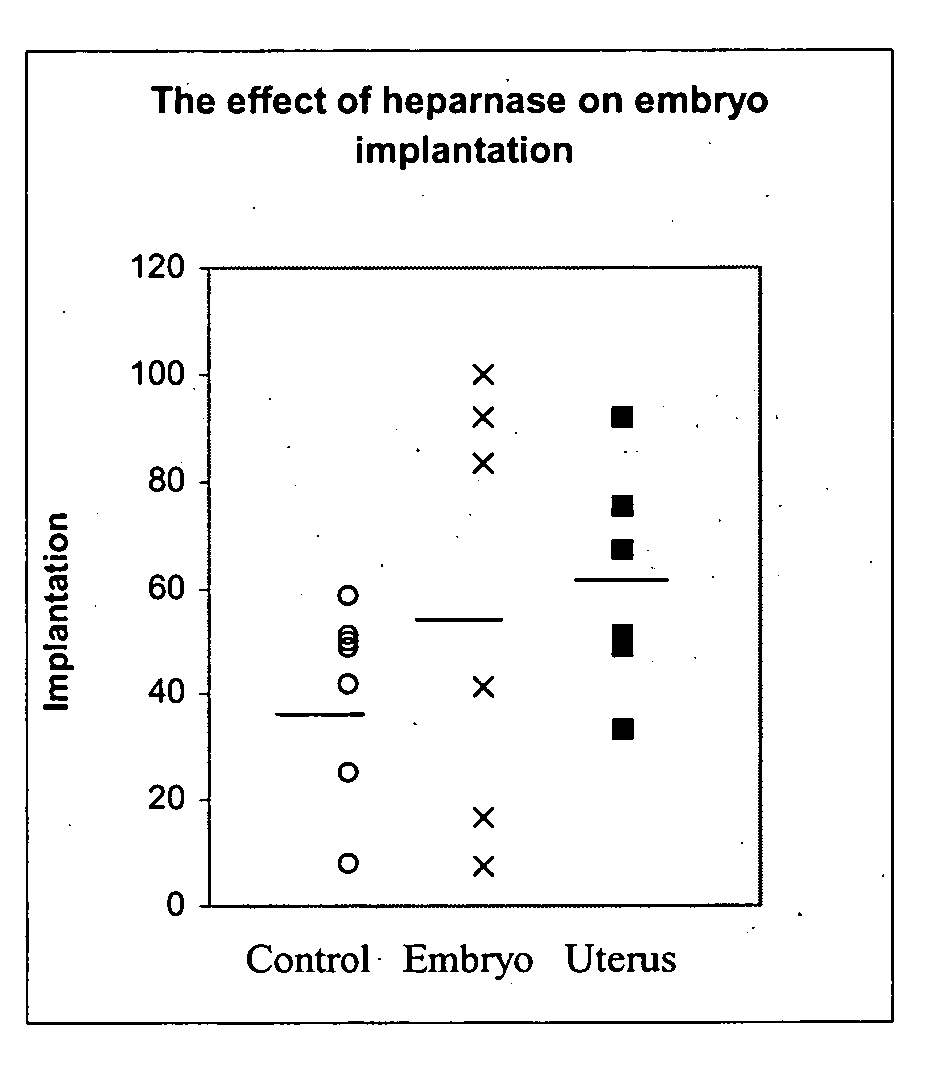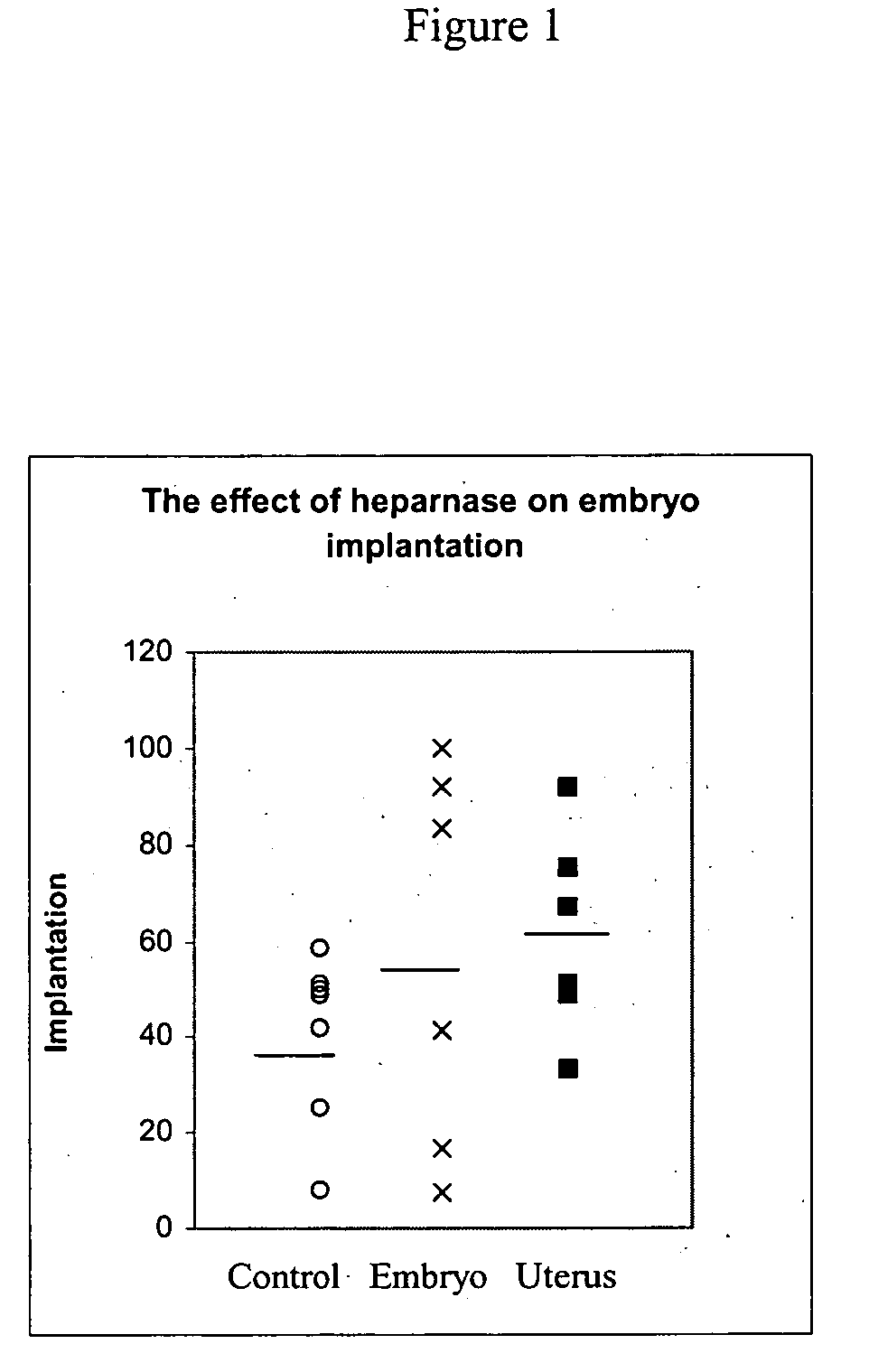Methods of and pharmaceutical compositions for improving implantation of embryos
a technology of in vitro fertilization and composition, which is applied in the direction of lysine, instrument, peptide/protein ingredient, etc., can solve the problems of increasing ivf has several significant problems, and the procedure is unpredictable, so as to increase the probability of embryo implantation
- Summary
- Abstract
- Description
- Claims
- Application Information
AI Technical Summary
Benefits of technology
Problems solved by technology
Method used
Image
Examples
example 1
Reproduction of Heparanase Transgenic Mice
[0092] Transgemic Mice:
[0093] Trangenic mice carrying and expressing the human heparanase gene are described in U.S. patent application Ser. No. 09 / 864,321, which is incorporated herein by reference. The following describes the generation of these transgenic mice and some of their phenotypes.
[0094] High level constitutive expression of heparanase was driven by chicken beta-actin promoter. The plasmid pCAGGS (Niwa, H et al. Gene 108: 193-200, (1991) was modified to contain a unique EcoRI site at position 1719. An XbaI-EcoRI 1.7 kb fragment, which contained the entire open reading frame of human heparanase was cloned into the compatible sites of the vector. Before injection, the plasmid pCAGGS-hpa was digested with SalI and PstI in order to isolate the expression cassette and eliminate bacterial DNA sequences. The resulting fragment contained the CMV-IE enhancer, chicken β-actin promoter and hpa cDNA followed by a rabbit β-globin poly adeny...
example 2
Quantitative Assessment of Murine Implantation Following Treatment with Heparanase
[0102] Materials and Experimental Procedures:
[0103] Mice:
[0104] 50 female and 17 male ICR (CD-1®) mice, about 8-12 weeks of age at study commencement and 50 female and 20 male CB6F1 mice, about 6-8 weeks of age at study commencement were used. ICR mice were used to obtain pseudopregnant females, whereas CB6F1 mice were used to obtain transplantable blastocysts. Test animals were kept under environmental controlled housing conditions throughout the entire study period and were maintained in accordance with Harlan Biotech Israel (HBI) approved Standard Operation Procedures (SOP's). At the termination of a three days acclimatization period, ICR female mice were individually identified by ear notching.
[0105] Heparanase:
[0106] CHO-p65 heparanase (1.693 mg / ml; Batch No. 11-1) was used in all experiments performed. CHO-p65 heparanase was prepared according to the the protocol described in WO 01 / 7297. The...
PUM
| Property | Measurement | Unit |
|---|---|---|
| concentrations | aaaaa | aaaaa |
| concentrations | aaaaa | aaaaa |
| catalytic activity | aaaaa | aaaaa |
Abstract
Description
Claims
Application Information
 Login to View More
Login to View More - R&D
- Intellectual Property
- Life Sciences
- Materials
- Tech Scout
- Unparalleled Data Quality
- Higher Quality Content
- 60% Fewer Hallucinations
Browse by: Latest US Patents, China's latest patents, Technical Efficacy Thesaurus, Application Domain, Technology Topic, Popular Technical Reports.
© 2025 PatSnap. All rights reserved.Legal|Privacy policy|Modern Slavery Act Transparency Statement|Sitemap|About US| Contact US: help@patsnap.com



